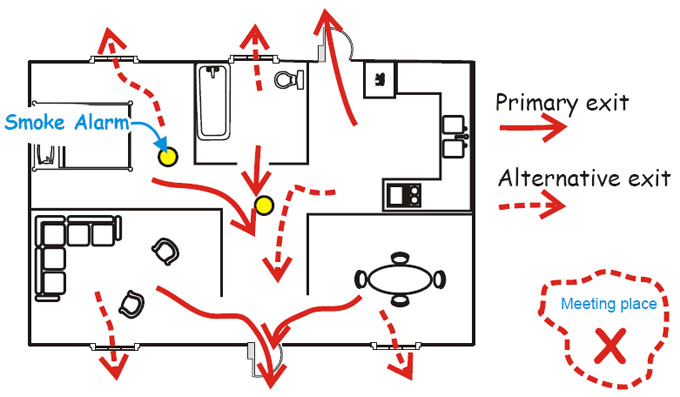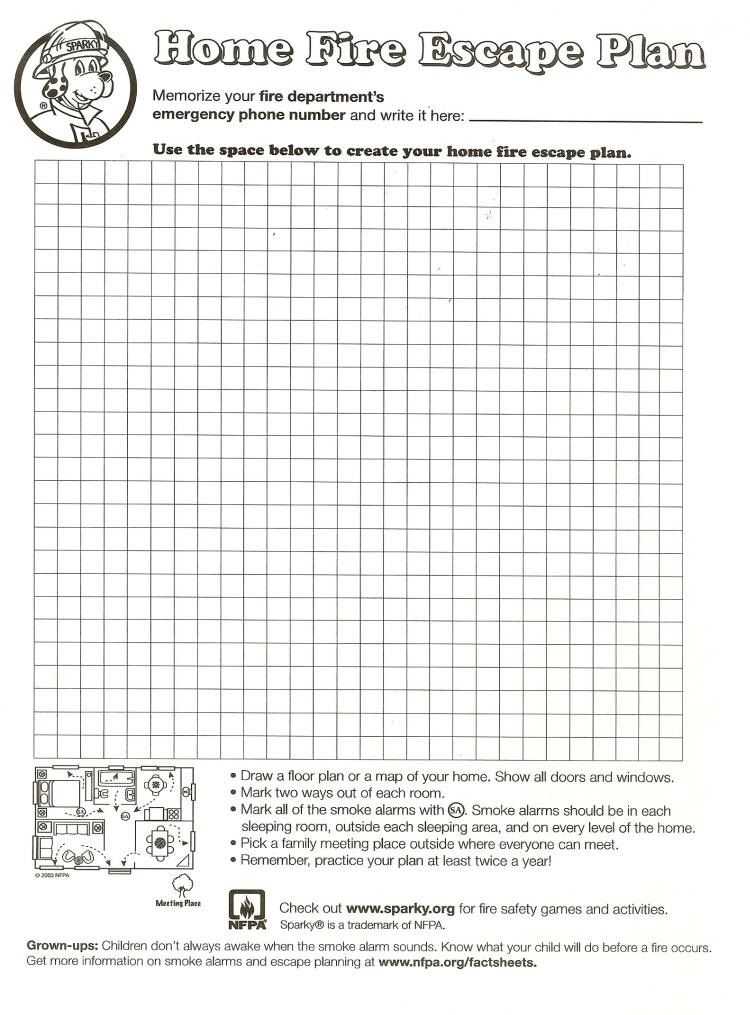Every person is responsible for their own fire safety. The damage caused by fire to your property and yourself is greatly reduced by ensuring that your home or building has the required fire protection systems and safety features. It is everyone’s responsibility to implement and practice the three lines of defence against fire: Prevention, Detection, Escape.
Additional Resources
Smoke Alarms
The Ontario Fire Code requires homes to have working smoke alarms on every storey. This is in addition to the requirement of having smoke alarms outside all sleeping areas. This applies to all single-family, semi-detached and town homes, whether owner-occupied or rented. Failure to do so will result in a fine of $360.
Fire Prevention Officers have the authority to lay charges with penalties up to $50,000 for smoke alarm infractions.
Landlords must ensure their rental properties comply with the law. Individual landlords who fail to comply with the Fire Code smoke alarm requirements can face penalties of up to $50,000 and up to a year in jail.
Tenants of rental properties are encouraged to contact their landlords immediately if they do not have the required number of smoke alarms. Once smoke alarms are installed, tenants cannot remove the batteries or tamper with the alarm in any way. If they do so, the tenant could be subject to a ticket for $360.
Sault Fire Services has adopted a zero-tolerance approach to smoke alarm violations. Smoke alarm violations including: missing/dead batteries, disabled alarms, and alarms not present on all storeys will result in charges.
Ontario fire statistics reveal that in about 50 per cent of fatal home fires, the victims had no smoke alarm warning.
Smoke Alarm Facts
- Test your smoke alarms once a month and change the batteries every year.
- If nuisance alarms are a problem, try moving the alarm to another location or purchase an alarm with a ‘hush feature’ that temporarily silences the alarm. Never remove the batteries from smoke alarms.
- Smoke alarms don’t last forever. Replace smoke alarms if they are more than ten years old.
- Make sure everyone in the household knows what to do if the smoke alarm sounds. Develop a home fire escape plan and practice it with the entire household.
Frequently Asked Questions
Are smoke alarms the law?
Yes, working smoke alarms are required by law. Working smoke alarms are required on all storeys of your home and adjacent to sleeping areas.
What happens if my smoke alarms are not working or not on all storeys?
Homeowners who do not comply with the Ontario Fire Code requirements with respect to working smoke alarms are subject to a $235 fine for each offence or penalties up to $50,000 and one year imprisonment.
Who's responsible for working smoke alarms?
In the case of a single family dwelling, it is the responsibility of the individual homeowner to ensure alarms are present and working. In the case of a multi-residential building, it is the responsibility of the building owner to provide the tenant a working alarm and instruction on its use.
Protocol should be established between the tenant and the owner (landlord) as to regular testing of the alarm. It is highly recommended that landlords and tenants regularly establish the presence of a working alarm and document that it has been tested and working properly.
What kind of smoke alarm should I buy?
We recommend electrical smoke alarms (hard wired) that are CSA approved and battery-operated smoke alarms that are ULC approved.
Where should I install smoke alarms?
The Ontario Fire Code requires all Ontario homes to have a working smoke alarm on every storey and outside all sleeping areas. The requirement covers single family, semi-detached and town homes, whether owner-occupied or rented.
How often should I replace my smoke alarm?
Studies have shown that alarms should be replaced after seven to 10 years.
Why does my smoke alarm go off a lot?
Carbon Monoxide Alarms
Carbon monoxide is a colorless, odourless, tasteless, and toxic gas, and is often referred to as the ‘silent killer’. It is commonly referred to as CO.
The Ontario Fire Code requires every home that has a risk of carbon monoxide poisoning install a CO alarm outside of sleeping areas. Dwellings may require more than one CO alarm if there are family members/residents sleeping on different levels of the home. Remember, it’s the law!
Who needs a Carbon Monoxide Alarm?
If the residence has a furnace, fossil fuel-burning appliance, or an attached garage, there must be a CO alarm installed outside of ALL sleeping areas. When properly installed, maintained and vented, any CO produced by these devices will not stay inside the home.
Sault Ste. Marie Fire Services would like to remind everyone to have furnaces and all other fossil fuel-burning appliances in their homes inspected by authorized service personnel, to prevent the serious hazards of carbon monoxide (CO) poisoning.
Signs and Symptoms
Exposure to CO can cause flu-like symptoms such as: headaches, nausea, dizziness, breathlessness, confusion, drowsiness, even loss of consciousness, and in severe cases CO poisoning can cause brain damage and death.
If you suspect carbon monoxide in your home
If you or anyone else in your home is experiencing the symptoms of CO poisoning, ensure that everyone leaves the home immediately and close the door behind you. Call your local fire department or 911 from outside the home or from a neighbour’s telephone.
Proper Placement
Proper placement of a CO alarm is important. They should be located in or as near as possible to the sleeping area of the home. Where sleeping areas are located in separate parts of the home, an alarm should be provided for each area.
CO alarms can be installed on low or high on the wall, or even on the ceiling. Please read manufacturer’s instructions for placement and further information.
To ensure the alarm will work properly, it should not be blocked by furniture, draperies, or other obstructions to normal air flow. If a combination smoke/carbon monoxide alarm is used, it should be located on the ceiling, to ensure that it will detect smoke effectively.
Beat the Silent Killer
- Be Responsible – All residents have a responsibility to know about the dangers of carbon monoxide. Knowledge and proactive actions can help save lives.
- CO alarms are a great safety tool. Always ensure that furnaces and fossil fuel-burning appliances are inspected and proper maintenance is performed regularly.
- Take the Test! Test CO alarms when you test your smoke alarms. CO alarms have a different sound than smoke alarms; know the difference!
All CO alarms should be tested at least once a month. Remember to change the batteries when you change your clocks!
Escape Plan
Do you know two ways out? Would you and your family be prepared if a fire happened in your home tonight? Everyone must know what to do and where to go when the smoke alarm sounds. Take a few minutes with everyone in your household to make a home Fire Escape Plan.
How to make your Home Fire Escape Plan
- Draw a floor plan of your home (make sure everyone has a copy)
- Show two ways out of every room (if possible)
- Decide in advance who will assist others (ex. children, seniors, mobility issues, etc.)
- Choose a meeting place (a safe distance from your home in the front yard)
- Call for help once escaped (if no one has a cell phone, go to a neighbour’s house to call 9-1-1)
- Practice your escape (make sure it is up to date and everyone knows the plan)
Planning to make a plan, is not a plan!
Don’t wait – tomorrow could be too late! Sit down with all members of the household to develop and update the Home Fire Escape Plan. Make sure that everyone participates in the practice.
Many households have escape routes that were planned when the kids were young. Make sure these plans are constantly updated with consideration to the current capabilities of everyone living in the residence. Always be prepared. Include children in the development of the plan to ensure that they know exactly what to do and why it is important to follow the plan.

